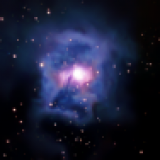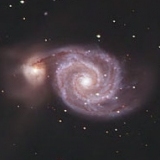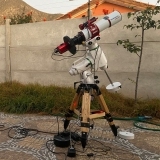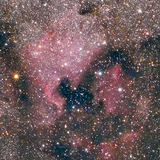INDI Library v2.0.7 is Released (01 Apr 2024)
Bi-monthly release with minor bug fixes and improvements
Newbie question: for guider scope, internal ekos vs PHD2?!!
Replied by Rene on topic Newbie question: for guider scope, internal ekos vs PHD2?!!
Rene
Please Log in or Create an account to join the conversation.
Replied by Bart on topic Newbie question: for guider scope, internal ekos vs PHD2?!!
Because of the issue, I reverted to PHD2, which works like a charm.
I don't agree with Rene's remark that it's another app to keep an eye on, since it 'just works' and even reports back the error values and the guide star image back to Ekos. Also dither works with out any problem. - only- thing is that you need to start it up, which you could auto-start on raspberry pi startup.
Cheers and have fun!
Bart
Please Log in or Create an account to join the conversation.
Replied by Doug S on topic Newbie question: for guider scope, internal ekos vs PHD2?!!
I recently switched to PHD2 and I am really glad I did. Slightly more complicated, but IMHO, worth it. I have nothing against the internal guider. It's just not as capable as PHD2. My specific original reason for switching was related to needing a good Polar Align drift align tool (I don't have a direct view of Polaris at my site). PHD2's drift align tool is exceptional. I would use this tool even if I did have a view of Polaris! Next, I wanted to analyze my mount's Periodic Error and fit a curve for upload to the mount. PHD2's log analysis tool for analyzing (post run) guiding is very solid. The tool is available here: adgsoftware.com/phd2utils/
After switching, I found PHD2 has several support tools on their "Tools" and "View" menus worth having. You might find the guide star calibration graph, Guide Assistant, Drift Align, or Guide Star Stats interesting and important. My advice would be to install PHD2, watch a couple of YouTube videos, and then decide for yourself whether you need or want its features over the internal guider. I found the case to switch compelling because I want every arcsec of mount performance improvement I can get! I can't live without the log viewer now! Cheers, Doug
Please Log in or Create an account to join the conversation.
Replied by Mohamed on topic Re:Newbie question: for guider scope, internal ekos vs PHD2?!!
Thank you
Mohamed
Please Log in or Create an account to join the conversation.
- David Tate
-

- Offline
- Elite Member
-

- Posts: 309
- Thank you received: 40
Replied by David Tate on topic Newbie question: for guider scope, internal ekos vs PHD2?!!
Please Log in or Create an account to join the conversation.
- Rick Wayne
-

- Offline
- Elite Member
-

- Posts: 222
- Thank you received: 20
Replied by Rick Wayne on topic Newbie question: for guider scope, internal ekos vs PHD2?!!
Please Log in or Create an account to join the conversation.
- Wouter van Reeven
-

- Offline
- Supernova Explorer
-

- Posts: 1957
- Thank you received: 420
Replied by Wouter van Reeven on topic Newbie question: for guider scope, internal ekos vs PHD2?!!
I am sorry to read that some Ekos users have problems with the internal guider. I do occasionally as well but have always been able to solve my issues with the help of this forum. As far as I am concerned there really is no need to not use the internal guider.
Wouter
Please Log in or Create an account to join the conversation.
Replied by Doug S on topic Newbie question: for guider scope, internal ekos vs PHD2?!!
In reading your reply to mhammady, I think your advice in this instance is not as good/fair as it should have been. If a mount has no issues (and it appears yours doesn't), great! The issue is that most mounts won't achieve peak performance until guiding is analyzed and adjustments are made. So, does the Ekos internal guider have the tools needed to help users identify under-performance and help analyze / correct? I think we both know the answer is not really. Just asking folks in the forum for advice is nice, but mhammady asked about the rationale for selecting one vs the other tool. Saying there's no need not to use the internal guider is definitely misguiding (pun intended)!
I gave examples earlier. Ekos can't analyze prior guiding (post-mortem log graphing), can't do frequency analysis to support PEC, can't show calibration backlash, has no guide assistant to help users in setting appropriate parameter values, is lacking in more guiding metrics than HFR (SNR, noise), lacks a good drift align tool, etc. etc. Again, there's no disrespect here for the internal guider. The internal guider works fine when there's no issue(s). However, if a user wants peak performance (or just to improve), then PHD2 has the tools to help achieve this. A lot of people worked really hard on that program, and it shows (just as it does for our beloved Kstars/Ekos).
For any new astrophotographer, I think it is very wise advice to pay attention to mount performance via guiding. If you want great narrow field images, you need a well tuned mount and great guiding. Having the right tools is half the battle. PHD2 can absolutely help in this particular area where kstars/ekos isn't quite as mature. As long as folks realize this, they'll be better informed. Cheers, Doug
Please Log in or Create an account to join the conversation.
- Wouter van Reeven
-

- Offline
- Supernova Explorer
-

- Posts: 1957
- Thank you received: 420
Replied by Wouter van Reeven on topic Newbie question: for guider scope, internal ekos vs PHD2?!!
The topic poster is new to astrophotography and to guiding, I merely wanted to show that using the internal guider is ok. I honestly think that for a beginner the internal guider is good enough. If one runs into issues then switching to PhD2 could lead to a solution exactly for the reasons you give. But I sometimes feel that unexperienced people may feel overwhelmed by possible issues while they simply are looking for some start up advise.
So, my advise remains: try the internal guider because it can give good enough performance. It it doesn’t then it is comforting to know that there are a lot of experienced people on this forum that can suggest solitions.
Clear skies, Wouter
Please Log in or Create an account to join the conversation.
- Rick Wayne
-

- Offline
- Elite Member
-

- Posts: 222
- Thank you received: 20
Replied by Rick Wayne on topic Newbie question: for guider scope, internal ekos vs PHD2?!!
I have since become a big fan of the SEP Multistar guiding algorithm, had problems with PHD losing stars from my off-axis guider. Whether it's the multi-star guiding or Ekos's fairly sophisticated stretching algorithm for guide images, the stars are much easier for both me and the computer to pick out. I do miss the Guide Assistant, but when I get right down to it I seem to be getting equivalent performance with less knob-twiddling. YMMV, of course!
Please Log in or Create an account to join the conversation.
Replied by Doug S on topic Newbie question: for guider scope, internal ekos vs PHD2?!!
Please Log in or Create an account to join the conversation.
- Matteo Gaetan
-

- Offline
- Junior Member
-

- Posts: 27
- Thank you received: 4
Replied by Matteo Gaetan on topic Newbie question: for guider scope, internal ekos vs PHD2?!!
For some reason, I could never get the internal guider to perform as well as PHD2. Even using the beautiful multi-star feature that PHD2 has been lacking. Until now.
When I say the same results, I am not talking about a couple of tenths of arc-sec, either. More like 25% to 75% higher total RMS error. This with both softwares using the predictive PEC algorithm and even on the same night, same subject, and few minutes after each other - so, seeing can't have changed that much, in such a small time window.
Another thing that PHD2 has and I highly appreciate is the Guiding Assistant, where it monitors a star and the behaviour of the mount and then suggests you the optimal settings for the guiding parameters.
Now they are finally adding to PHD2 the only thing that it was laking: multi-star guiding. People that have tried it already are reporting in a CloudyNights thread better guiding by 50-90% with it enabled vs normal single star guiding.
It's just a matter of waiting until they release it (it's in "DEV" state) and being ported to Raspberry/Astroberry. Can't wait!
Please Log in or Create an account to join the conversation.

